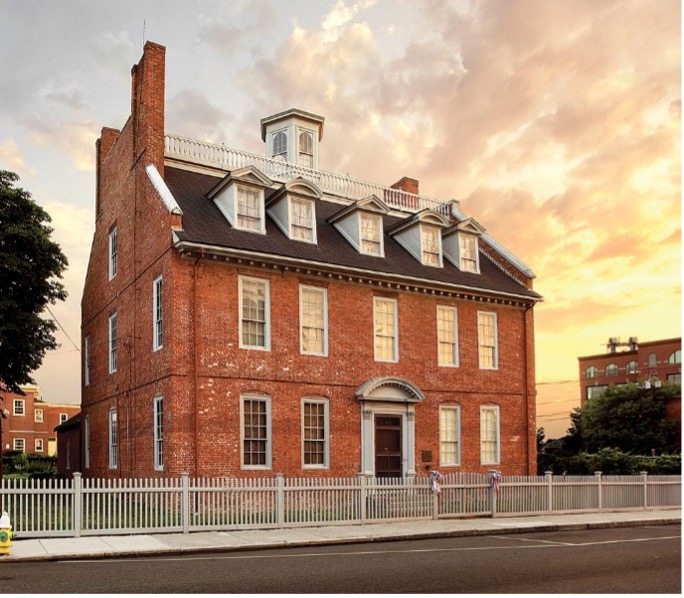By Mike Anderson
December 2, 2023 – Long before there was a “Billboard Hot 100” or Casey Kasem’s “American Top 40 Countdown,” a song’s popularity might have been gauged by how often people sang it in their living rooms – or taverns. We will never know for sure which songs were the most popular in 1623, but tonight, before a small crowd at the Warner House, lutist Joel Spears played music that might have been performed here 400 years ago.
Spears began his performance (part of the Portsmouth 400 celebrations) with music reflecting the Native American groups in the area. His first piece was based on an Abenaki melody, not an ancient one, but still indigenous.
No record survives to tell us what Native American people here might have listened to. It would be interesting to know more about their instruments and traditional melodies. (Dear Warner House: consider this a plug for a future performance, or at least a lecture, by an Abenaki musician).
Diverse influences
Spears also played several songs influenced by African music. He noted that the first African person arrived in Portsmouth in 1645, probably from Ghana.
Africans brought their music to the New World, and it found its way to Europe, as well. Some African music found a warm welcome to the music scene in Europe.
Other tunes from Africa were so lively that they were banned, Spears said, lest they corrupt the youth. (One can imagine the rebellious teenagers, smoking clay pipes in the boys’ room, their powdered wigs turned backwards, singing banned African songs.)
The real rebels of that era were the Scots. Following the English Civil War, Oliver Cromwell ran Britain as a “protectorate.”
The Scots weren’t happy with Cromwell. It came to blows, and Cromwell’s army defeated the Scots, many of whom resettled in New England (not always on a voluntary basis). Spears played a couple of Scottish songs known as “ports,” a word based on a Gaelic term for “tune.”
The lute’s presence in early colonial music
Spears explained that music for the lute would certainly have been circulating in the New England colonies in the early 1600s. William Brewster brought tablature (a form of musical notation) aboard the Mayflower for songs to be played by lute.
These songs were the Psalms set to music, and they were created by Robert Allison. Although this religious music would have been preferred by the Pilgrims and Puritans, Allison also wrote music for recreation, like playing cards.
Spears played one of Allison’s compositions for card games. It was supposed to be battle-like; to the modern ear, it was decorous, but also spirited.

The evening combined history with genuinely beautiful music. Spears is a gifted lutist, and he knows his instrument well.
(He takes care of it well, too – for his flight from Chicago, he bought a ticket just for the lute, and it sat in the seat next to him.)
He said that the lute, a stringed instrument with 10 pairs of strings, dates back to the Middle Ages, and instruments like it go back to ancient times (truly ancient times – Spears said depictions of lute-like instruments can be found in ruins from Babylon).
The lute has a crooked neck and a gourd-like body. The word means “wood,” and probably came from Arabic.
It was, Spears noted, “the guitar of 1623.” Lutes were tremendously popular, and much like pianos in the nineteenth and early twentieth century, they would have been found in many American homes. The lute was, however, associated with the aristocracy, and after the revolutions in America, France and elsewhere, it fell out of favor.
The Warner House: a unique venue
“The Greatest Hits of 1623” took place in the ballroom on the second floor of the Warner House – a unusual and delightful room, treated with a special application called “smalt.” Finely crushed glass covers the cobalt paint on the walls, creating a glittering effect.
The floor in the room is a floating floor, with no nails. It was said to be excellent for dancing. Spears said that all the wood in the room gave it excellent acoustic quality.
This was the first musical performance in the Warner House in 50 years, according to local historian Richard M. Candee.
It was also one of many events to take place at the site this winter.
A carriage house was recently added to the property. It has a handicapped-accessible bathroom and heat – two improvements over the Warner House itself.
Free lectures and events will occur there in the months to come. Please see Events — The Warner House for details.
Site Coordinator Stephanie Hewson suggested confirming events by contacting the staff in advance. Call (603) 436-5909 or send email inquiries to info@warnerhouse.org. The Warner House is located at 150 Daniel Street in Portsmouth.
The 1716 Warner House was built for Archibald Macpheadris and descended through his family until 1931, when it became a museum. The Warner House Association has owned and operated the museum since then and offers a variety of educational and public programs. Guided tours are available seasonally, late May through mid-October. Its outstanding collection includes family-owned furniture, textiles, and personal belongings as well as a world-renowned ceramics collection. The oldest extant wall murals reside in the entry hall and depict two Mohawk Sachems, who were painted ca. 1720.











